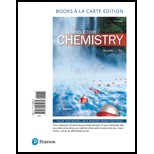
Interpretation: The hydrocarbons that are liquids at room temperature given in the table are to be determined. The trends in the melting and boiling points of the given hydrocarbons are to be described and the regular trend is to be identified. The types of intermolecular forces present in the given hydrocarbons are to be identified and the boiling point trend is to be explained on the basis intermolecular forces. The graph between boiling point and molar mass of hydrocarbons is to be drawn. From the graph drawn, the boiling point of heptane is to be predicted.
Concept Introduction: The lower mass hydrocarbons have low boiling point and usually, they evaporate at room temperature.
The hydrocarbon with higher molar mass exists as a liquid at room temperature.
The boiling point of hydrocarbon increases with increase of molar mass.
The dispersion force exists between the hydrocarbons.
Greater the dispersion forces, higher will be the boiling point.
Want to see the full answer?
Check out a sample textbook solution
Chapter 12 Solutions
Introductory Chemistry, Books a la Carte Edition (6th Edition)
- Which of the following has the highest boiling point? ethane, CH3CH3 formaldehyde, HCHO dimethyl ketone, CH3COCH3 ethyl alcohol, CH3CH2OH acetic acid, CH3COOHarrow_forwardWhich of the following will have the lowest boiling point? a. carbon tetrachloride b. CHCl3 c. Methane d. CH2Cl2 e. CH3Clarrow_forwardWays to separate water and alcohol and its step by step processarrow_forward
- Define and explain London dispersion forcesarrow_forwardPredict the relative boiling points of the substances in Figure 9 and rank these boiling points from the highest to the lowest. [The sign ~means approximately equal.] * a) B > D > A > C b) D > B > A > C c) C > B > A > D d) B > A ~ D > C e) The boiling points of these compounds cannot be compared with our current model.arrow_forwardIdentify from the given set of molecules exhibits higher boiling point and lower vapor pressure. H2O and CH4 NH3 and C2H5OH C2H6 and C4H10 C3H8O and H2O C5H12 and C2H5OHarrow_forward
- box the molecules that will hydrogen-bond with water molecules.arrow_forwardWhat is the main purpose of recrystallisation? A. Chemists recrystallise solids when they want to change big crystals into small crystals. B. Chemists recrystallise solids that are contaminated with impurities. If done properly, the solid will then recrystallise in a purer form. C. Chemists recrystallise solids when they want to change small crystals into big crystals.arrow_forward54. The structural isomers C2H5OH and CH3OCH3 would be expected to have the same values for which of the following? (Assume ideal behavior.) (A) Gaseous densities at the same temperature and pressure (B) Vapor pressures at the same temperature (C) Boiling points (D) Melting points (E) Heats of vaporizationarrow_forward
- A student synthesizes an impure product of a compound with a melting point known to be 117 °C. Which of the following could be in their measured melting point, assuming the sample is mostly the product? 120 °C 136-137 °C 50 °C 98-104 °C 116-117 °Carrow_forward. Based on what you have studied about intermolecular forces, predict which of the following liquid has the highest boiling point and why. All three compounds have comparable molecular weights. Butane, C4H10 Propanol, C3H7OH . Acetone, CH3COCH3arrow_forwardPure acetic acid has a melting point of 16.7 degree Celsius and a boiling point of 118 degree Celsius. Predict the physical state of acetic acid when the temperature is 10 degree Celsius.arrow_forward
 Introduction to General, Organic and BiochemistryChemistryISBN:9781285869759Author:Frederick A. Bettelheim, William H. Brown, Mary K. Campbell, Shawn O. Farrell, Omar TorresPublisher:Cengage LearningChemistry: Matter and ChangeChemistryISBN:9780078746376Author:Dinah Zike, Laurel Dingrando, Nicholas Hainen, Cheryl WistromPublisher:Glencoe/McGraw-Hill School Pub Co
Introduction to General, Organic and BiochemistryChemistryISBN:9781285869759Author:Frederick A. Bettelheim, William H. Brown, Mary K. Campbell, Shawn O. Farrell, Omar TorresPublisher:Cengage LearningChemistry: Matter and ChangeChemistryISBN:9780078746376Author:Dinah Zike, Laurel Dingrando, Nicholas Hainen, Cheryl WistromPublisher:Glencoe/McGraw-Hill School Pub Co

